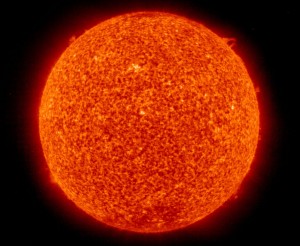16 August 2011
A quieter sun won’t make up for global warming
Posted by kramsayer

On March 18, 2009, an image of the Sun shows its face without any sunspots during a lull in solar activity. (Credit: SOHO (ESA & NASA))
The Sun seems to be taking a bit of a rest. In recent years, scientists have detected fewer sunspots on the star’s surface, and many expect that number to drop further in coming decades — possibly echoing the Maunder Minimum, a period of low solar activity that happened centuries ago.
But a decrease in the number of sunspots would not have much of a cooling effect on Earth over the next century, according to new research accepted for publication in Geophysical Research Letters. And it would not be able to make up for predicted human-caused increases in global temperatures.
Recent studies have compared a 2008-2009 slump in solar activity to the Maunder Minimum — a span in the late 17th century with very few sunspots that coincides with a period of cooler climate often called the “Little Ice Age.” But it’s unclear how much lower the solar irradiance during the Maunder Minimum actually was, says Georg Feulner, a senior research fellow with the Potsdam Institute for Climate Impact Research in Germany.
Feulner examined two recent estimates made by different researchers that represented different extremes: one that proposed a small difference between recent solar activity and the Maunder Minimum, and another one that stated the late 1600s saw much less solar irradiance than recent years. Plugging those estimates into a climate model, Feulner compared the results with reconstructed temperatures for the past millennium.
The resulting temperatures from the model matched up best with reconstructed past temperatures when the model assumed there was a small difference of solar activity between the Maunder Minimum and the recent solar slump.
“The solar irradiance during the Maunder Minimum probably wasn’t that much smaller than today’s,” Feulner says. But that small difference in solar activity is sufficient to explain the colder temperatures of the Little Ice Age when combined with other factors, such as a drop in the amount of greenhouse gases and volcanic eruptions during the Maunder period, he explains.
When the model assumed that the solar irradiance was much lower during the Maunder Minimum compared to 2008-2009, it didn’t mesh as well with reconstructed past temperatures, Feulner says. Temperature fluctuations over time were amplified by a factor of two in the model, compared to the reconstructed temperatures.
So, according to the results, it’s likely that the solar irradiance low of two years ago was more similar to the solar activity during the Maunder Minimum. Feulner then looked at what these results mean for the coming century if we enter a solar period like the Maunder Minimum again. The answer: not too much.
“The temperature decrease, or the cooling you would get from such a new Maunder Minimum, is pretty small,” Feulner says. “Probably 0.1-0.3 degrees Celsius (0.18 to 0.54 degrees Fahrenheit) at most, for the global mean temperatures.”
This decrease in temperature would not even make up for the predicted warming due to greenhouse gas emissions – global surface temperatures are predicted to increase 1.4-4.8 degrees Celsius (2.5-8.6 degrees Fahrenheit) relative to preindustrial times by the end of the century, Feulner notes in the study. “We have already produced so much warming, and will keep on doing so in the future, that a slight drop in solar activity won’t help us much,” Feulner says.
![]() Feulner, G. (2011). Are the most recent estimates for Maunder Minimum solar irradiance in agreement with temperature reconstructions? Geophysical Research Letters
Feulner, G. (2011). Are the most recent estimates for Maunder Minimum solar irradiance in agreement with temperature reconstructions? Geophysical Research Letters
– Kate Ramsayer, AGU science writer


 GeoSpace is a blog on Earth and space science, managed by AGU’s Public Information staff. The blog features posts by AGU writers and guest contributors on all sorts of relevant science topics, but with a focus on new research and geo and space sciences-related stories that are currently in the news.
GeoSpace is a blog on Earth and space science, managed by AGU’s Public Information staff. The blog features posts by AGU writers and guest contributors on all sorts of relevant science topics, but with a focus on new research and geo and space sciences-related stories that are currently in the news.
Propaganda! Otherwise the writer don’t get paid.
[…] GeoSpace- Have you heard someone say that we’re heading for a low in solar activity which could counteract global warming and instead cause global cooling? It’s not a claim made by anyone who’s familiar with the science. Even if the low does occur and stick around for a while, it really won’t make a difference. Check some recent details here. Advertisement GA_googleAddAttr("AdOpt", "1"); GA_googleAddAttr("Origin", "other"); GA_googleAddAttr("theme_bg", "000000"); GA_googleAddAttr("theme_border", "333333"); GA_googleAddAttr("theme_text", "b8babb"); GA_googleAddAttr("theme_link", "7f8e91"); GA_googleAddAttr("theme_url", "7f8e91"); GA_googleAddAttr("LangId", "1"); GA_googleAddAttr("Autotag", "science"); GA_googleAddAttr("Tag", "popsci-links"); GA_googleFillSlot("LD_ROS_300-WEB"); Share this:ShareLike this:LikeBe the first to like this post. This entry was posted in PopSci Links. Bookmark the permalink. […]
[…] pesquisador sênior doInstituto Potsdam para pesquisa do Impacto Climático, na Alemanha. Read more… Share this:Like this:LikeBe the first to like this post. CategoriasAquecimento Global, […]
The only problem with that theory is, it’s purely a short term observation, as opposed to our modern maximum AND the upcoming maximum for next year into 2013.
Indeed, we’ve had a few highly energetic sunspots in the past few months, which were replete with many CME’s and flares galore.
I happen to monitor the SWPC mailing list, an old habit that dates to back when I relied upon portable satellite uplinks in the military.
The current trend is for a very active solar maximum during this cycle, which is opposite what the paper discusses.
So, if anything, global climate will warm by a fraction of a degree MORE than is a claimed loss in that paper.